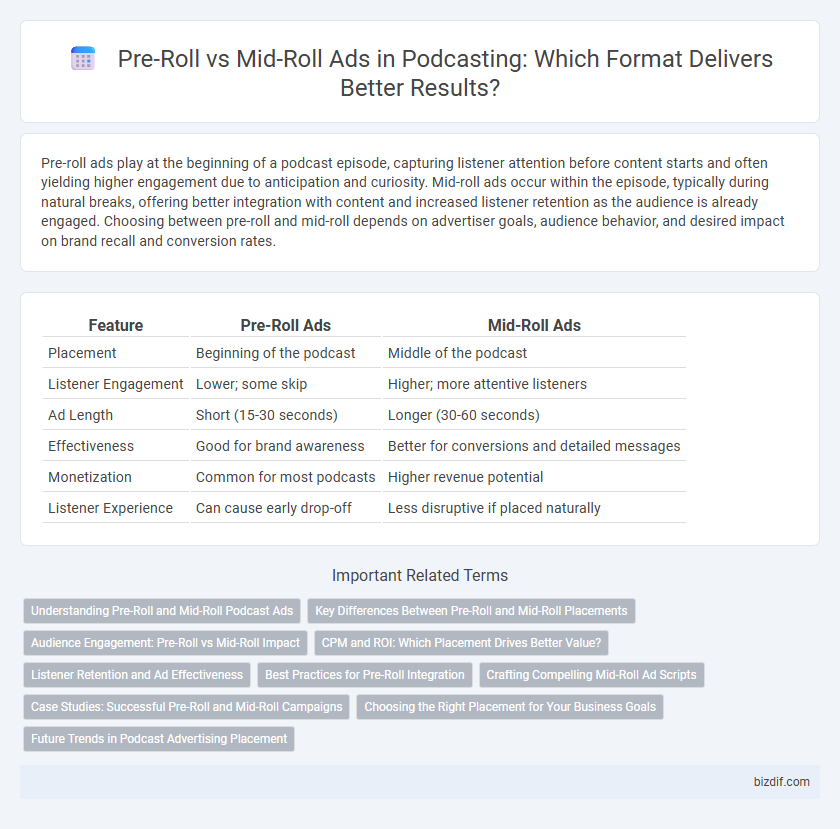Pre-roll ads play at the beginning of a podcast episode, capturing listener attention before content starts and often yielding higher engagement due to anticipation and curiosity. Mid-roll ads occur within the episode, typically during natural breaks, offering better integration with content and increased listener retention as the audience is already engaged. Choosing between pre-roll and mid-roll depends on advertiser goals, audience behavior, and desired impact on brand recall and conversion rates.
Table of Comparison
| Feature | Pre-Roll Ads | Mid-Roll Ads |
|---|---|---|
| Placement | Beginning of the podcast | Middle of the podcast |
| Listener Engagement | Lower; some skip | Higher; more attentive listeners |
| Ad Length | Short (15-30 seconds) | Longer (30-60 seconds) |
| Effectiveness | Good for brand awareness | Better for conversions and detailed messages |
| Monetization | Common for most podcasts | Higher revenue potential |
| Listener Experience | Can cause early drop-off | Less disruptive if placed naturally |
Understanding Pre-Roll and Mid-Roll Podcast Ads
Pre-roll and mid-roll podcast ads differ primarily in placement and listener engagement levels, with pre-roll ads airing at the beginning and mid-roll ads inserted during content breaks. Pre-roll ads benefit from higher listener retention rates since they play before the main content, while mid-roll ads often achieve better recall due to being integrated within the episode when listeners are already invested. Understanding ad type effectiveness helps advertisers optimize reach, engagement, and conversion metrics in podcast marketing campaigns.
Key Differences Between Pre-Roll and Mid-Roll Placements
Pre-roll ads play before podcast content begins, capturing listeners' full attention during peak focus but risking skips if too long. Mid-roll ads appear within the episode, benefiting from higher engagement since listeners are already invested, often leading to better recall and conversion rates. The key difference lies in timing and listener engagement, with pre-roll maximizing reach upfront and mid-roll optimizing ad effectiveness through contextual integration.
Audience Engagement: Pre-Roll vs Mid-Roll Impact
Pre-roll ads often face lower audience engagement due to listener skippage or tuning out before the content begins, making them less effective for capturing attention. Mid-roll ads benefit from higher engagement rates by interrupting the content during peak listener attention, resulting in increased ad recall and response. Studies show mid-roll placements can generate up to 2-3 times more listener interaction compared to pre-roll spots.
CPM and ROI: Which Placement Drives Better Value?
Pre-roll ads typically command higher CPM rates due to guaranteed listener engagement at the episode's start, but mid-roll ads often deliver superior ROI by capturing attention during peak listening moments, increasing conversion potential. Brands prioritizing CPM may prefer pre-roll placements for consistent exposure, while those focused on ROI benefit from mid-roll slots that leverage listener immersion. Data from podcast advertising reports indicate mid-roll ads can boost response rates by up to 30%, optimizing both engagement and revenue outcomes.
Listener Retention and Ad Effectiveness
Pre-roll ads often deliver higher listener retention due to placement at the podcast's start when engagement is highest, making them less likely to be skipped. Mid-roll ads, embedded within content, benefit from deeper listener immersion, enhancing ad effectiveness through contextual relevance and increased recall. Combining pre-roll and mid-roll strategies optimizes overall ad performance by balancing immediate attention capture with sustained listener trust and engagement.
Best Practices for Pre-Roll Integration
Effective pre-roll integration in podcasting involves placing ads at the beginning of the episode to capture listener attention before content engagement declines. Best practices recommend keeping pre-roll ads concise, ideally under 30 seconds, and ensuring they are relevant and seamlessly aligned with the podcast's theme to maximize listener retention and ad recall. Utilizing host-read endorsements in pre-roll spots can enhance authenticity, fostering greater trust and responsiveness among the audience.
Crafting Compelling Mid-Roll Ad Scripts
Crafting compelling mid-roll ad scripts demands an understanding of listener engagement peaks, typically occurring mid-episode when attention is highest. Integrating storytelling techniques and relatable messaging within 30- to 60-second spots enhances ad recall and brand affinity. Data shows mid-roll ads yield 2x higher listener retention rates compared to pre-roll placements, emphasizing the importance of tailored, contextually relevant scripts.
Case Studies: Successful Pre-Roll and Mid-Roll Campaigns
Case studies demonstrate that pre-roll ads achieve higher brand recall, with a 30% increase in listener attention during the initial content phase, while mid-roll ads drive 25% greater purchase intent due to their placement amid engaging segments. Spotify's mid-roll campaign for Nike resulted in a 20% boost in click-through rates, contrasting with Mailchimp's pre-roll ads that enhanced brand awareness by 35% across diverse podcast genres. These data points highlight the strategic value of deploying pre-rolls for broad reach and mid-rolls for targeted listener engagement in podcast advertising.
Choosing the Right Placement for Your Business Goals
Selecting the optimal ad placement in podcasting, such as pre-roll or mid-roll, depends on your business objectives and target audience engagement. Pre-roll ads capture listener attention before content begins, making them ideal for brand awareness and broad reach, while mid-roll ads occur during the episode and typically yield higher listener engagement and conversion rates. Evaluating factors like ad length, message complexity, and campaign goals ensures effective alignment with your marketing strategy.
Future Trends in Podcast Advertising Placement
Future trends in podcast advertising placement indicate a shift toward dynamic insertion, with mid-roll ads gaining prominence due to higher listener engagement and better performance metrics. Advances in programmatic technology enable more personalized and contextually relevant ad experiences, enhancing ROI for advertisers. Integration of AI-driven analytics is expected to optimize ad timing and content, maximizing audience retention and conversion rates.
Pre-Roll vs Mid-Roll Infographic

 bizdif.com
bizdif.com